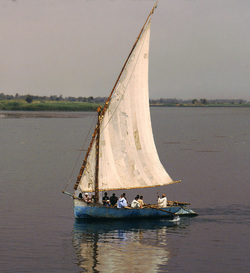
 I am currently editing a small Greek papyrus that refers to a boat in the harbor of a monastery, which belongs to a certain Victor. Since transportation in Egypt was frequently done by boat along the Nile, it is no surprise that we find many references to boats in the papyri. Boats were most often owned by social elites, such as officials, aristocrats, and wealthy businessmen. What is surprising (at least to me anyway) is that several papyri actually mention boats that were owned by monasteries, bishops, and monks. From two related fourth century papyri (P.Col. 7.160 and 161), we learn that a bishop by the name of Hierapollon owned four boats. In P.Harr. 1.94 (fourth century), we learn that a Christian priest named Apollonius, son of a bishop named Dionysus, was the owner of a boat. P.Oxy. 34.2729, a fourth century Christian letter, mentions the boat of Thodoros the bishop. These boats were most likely the private property of well-to-do Christian clergy or their churches/monasteries. Jean Gascou has argued that monasteries made their boats available to the service of the state. Certainly, from the documentary record, we can see that some monastic communities were holders of much property and other kinds of assets. Perhaps some monks retained portions of their pre-monastic wealth. Some of these possessions were used to generate income and establish monastic estates. We learn of the leasing of part of a water wheel (P.Oxy. 16.1900), a boat anchor (SB 8.9683), and land (P.Ross.Georg. 3.48). Anyway, monastic life didn’t always mean empty, unadorned, and dark cells. Some monastic circles were participating in the lively economy of Byzantine Egypt just like everyone else. And some apparently had boats!
0 Comments
Your comment will be posted after it is approved.
Leave a Reply. |
Archives
August 2015
Categories
All
|
